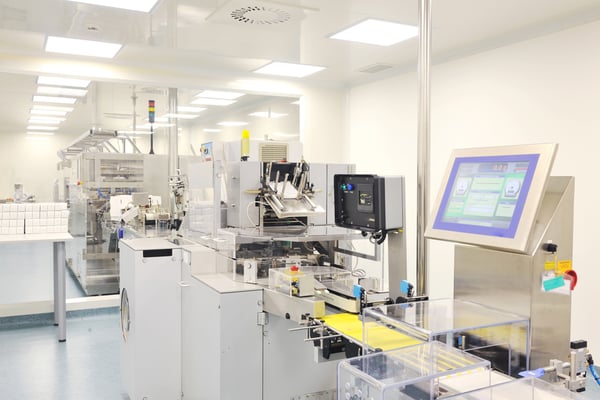
Heavy-duty hinges are all about doing a job smoothly and repeatedly without compromising the quality of the overall product. Particularly in medical and scientific applications, hinges are critically essential to the continued functionality of often-expensive equipment.
As a result, there are many hinge design guidelines specific to these industries that can make or (literally) break your project's success. Below, we'll discuss five considerations for heavy-duty hinges, and the guidelines that ensure they function perfectly.
5 Hinge Design Guidelines
Whether you’re designing an ultra-low-temperature-freezer or a centrifuge for a medical laboratory, these are five hinge design parameters you likely need to consider:
- Contamination
- Cycle life and reliability
- Weight & counterbalancing
- ESD
- Heat/cold resistance
1. Contamination
When dealing with medical and scientific equipment, there are many strange and unsafe substances involved. In these applications, hinges absolutely cannot fail and contaminate assets around them. Cross-contamination can cause costly damage to equipment, not to mention patients and staff.
In lab applications, hinges are often used to protect an enclosed asset or product, or make a heavy door or lid easy to lift. The seal of a vacuum chamber door hinge design, for instance, securely isolates objects inside. If a hinge produces even the smallest amount of aerosol or particulate contamination, the entire chamber is compromised, which could ruin the experiment or the product itself.
Sealing is equally essential in medical applications. A medical incubator, for example, needs to stay free of contamination, even from the components that comprise it.
Heavy-duty hinge lubricants also must avoid becoming a contamination risk. In medical uses, leaking grease or oil can be extremely harmful (which is why gas springs are a bad idea). Always consider food-grade grease for medical applications.
2. Cycle Life and Reliability
Medical and science equipment frequently protect very valuable assets. A failed hinge can cause thousands of dollars to come crashing down -- and hopefully not on someone’s fingers or head. Follow your manufacturer’s hinge design guidelines to reach the optimal life span for your hinge. Cheap materials and design will get you cheap results.
Using hinges with a long cycle life reduces equipment failures and downtime from not having equipment available when you need it. Consider your applications’ load and frequency of use. High-frequency traffic is typically considered more than 25 uses per day and a load of up to 200 lbs.
There are other safety considerations when it comes to reliability. With heavy-duty medical equipment such as floor model centrifuges, failing hinges could create a serious workplace hazard. Not only could equipment failures cause costly damage, they could also result in employee injuries and patient lawsuits.
3. Weight and Counterbalancing
One of the key hinge design guidelines for medical and scientific applications is accounting for weight with a reliable backup plan. Sensitive and/or heavy equipment is often highly susceptible to breaking. A complex hinge design -- usually through counterbalancing -- can help you better control a door or lid’s motion so it doesn’t slam violently.
Repeated opening of heavy lids is also a common pain point in healthcare ergonomics, leading to injuries and long-term strain. For example, vacuum chamber lids can be over 80 lbs.
The right hinge can alleviate the strain of opening such a heavy container repeatedly. A reliable counterbalance hinge ensures that motion is smooth and safe through the entire range of the door or lid. This ensures that there’s no need for door stays or other Band-Aids, and that the weight is balanced at all points on the hinge's motion, creating predictable operation.
4. ESD
Serious sophistication goes into the design of complex medical and scientific equipment. Electrostatic discharge (ESD) can build up from seals of doors opening and closing. This discharge of static buildup can fry sensitive electronic components in a centrifuge, freezer, or fridge door.
Hinges on complex electronics need to be properly grounded to prevent damage from static discharge. Alternative materials and specialized components are available that ensure metal surfaces don't collect harmful static electricity and damage equipment.
5. Heat/Cold Resistance
Medical and science equipment often live in hot, cold, and potentially corrosive environments, yet heavy-duty hinges are still expected to be up to the task.
An ultra-low-temperature freezer, for instance, will require that hinges be up to the challenge of functioning in extreme cold without degrading in force over time. Extreme-temperature applications require auditing materials, finish, and spring type to ensure continued durability of the hinge.
Certain substances may have a corrosive effect on your hinge over time. To keep your hinge lasting long, consider corrosion-resistant materials like stainless steel (which is also easy to clean) or copper (which has the bonus of being antimicrobial).
Hinges: The Heartbeat of Your Design?
Safe, convenient, and reliable motion control is possible by following these five vital hinge design guidelines.
If you’re new to designing for counterbalancing and ergonomics, your head might still be spinning like a centrifuge. If you have a specific design concern about motion control or counterbalancing, message an engineer directly today:
.png?width=12000&height=2033&name=WeberKnappLogo_white%20(1).png)


